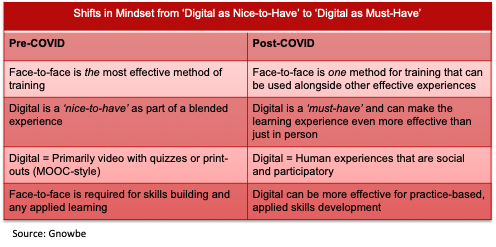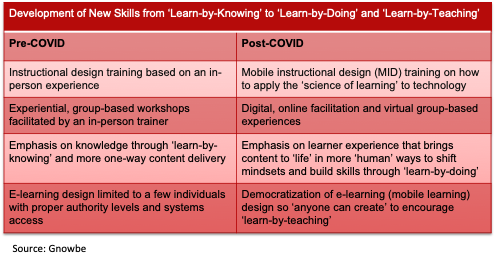We are in the midst of a massive global social experiment that challenges the nature of our day-to-day, face-to-face training, meetings and work. What does it mean to work if you cannot meet face to face with colleagues or clients? How can employees and lifelong learners train and acquire new skills if they cannot have the group-based, facilitated training sessions that have been the norm for decades? How can leaders manage the performance of their remote teams and gain real-time engagement and feedback?
Long after the lockdowns are over, one permanent effect of the COVID-19 pandemic will be changes to traditional modes of learning, communicating and working in the modern world. Just what will that experience of training, engaging and working look like in this new “low-touch” economy?
I believe that on the other side of this pandemic, we will see a shift in mindset about what “training” really means. There will be a new openness about the development of digital skills and, ultimately, a more inclusive approach to how we choose the technologies we use for training.
Mindset Shifts
How long have we heard that widespread work-from-home policies were impractical for most businesses? How long have we been told that in-person, face-to-face training was the only real way to learn? Thanks to the pandemic, we know that neither of those statements is true, after all.
Many companies were thrust unprepared into remote work and remote learning and had to adapt quickly to the new reality. And adapt they have — while there are businesses that will always need face-to-face interaction, for many roles in most “white-collar” industries, one of the most lasting repercussions of COVID-19 will be the end of “face-to-face is best” thinking. With so many businesses able to maintain service levels remotely, the idea that work needs to return to in-office, face-to-face interactions is neither tenable nor necessarily the most effective.
For most businesses, online training will move from something seen as a “nice-to-have” to an accepted, “must-have” part of a blended working and learning environment. It will become part of the “new normal.”

The Development of New Digital Skills
The shifting mindset brought about by the pandemic will also impact how training happens and how new skills are acquired in the workplace. The current model is heavily focused on either group-based, instructor-led training (ILT) or webinars, mostly for technical or compliance training. The latter approach is often little more than slide decks, followed by a Q&A session.
I believe that, in the wake of the pandemic, traditional instructional design will likely be replaced with more modern thinking about mobile-first learning. Mobile instructional design can apply the science of adult learning to instructional opportunities that are increasingly mediated by smartphones, tablets and personal computers.
Likewise, I anticipate that the one-sided webinar information dump that many are calling a “shift to digital” will refocus around virtual, group-based experiences, with instructional content presented digitally but in a far more human way than pre-pandemic online learning models traditionally allowed.

New Decision-making Criteria
The third change I expect to see is in who makes decisions about workplace technologies. Up until this point, organizations made technology decisions from the top down: Executives, including the chief information officer (CIO), called the shots on which technologies the organization adopted to solve what they perceived as business needs or pain points. In most cases, the people who would be using those technologies were informed which platforms and programs they would have access to and then received training (or not) on how to use them.
With the pandemic, however, and the mainstreaming of remote work, expect to see more of a democratization of decision-making. I expect that executives will consult the in-the-trenches workforce more widely and more frequently on which programs the business should use. We should also anticipate more openness to a diverse set of solutions; more emphasis on innovation; and less emphasis on top-down, one-size-fits-all technology purchases. Users will have more freedom to choose apps and software that help them in their specific role, and managers and other executives should be more open to input from staff around which programs they should purchase and why.

We are living in a new low-touch economy. It’s time to adapt and shift our mindsets, develop new skills and rethink how we make decisions to stay agile, connected and human.


